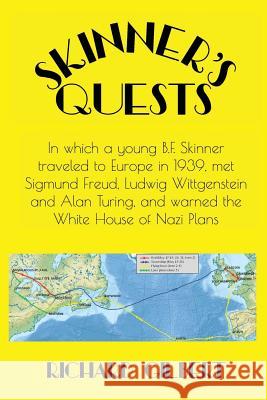Skinner's Quests » książka
Skinner's Quests
ISBN-13: 9780991956241 / Angielski / Miękka / 2016 / 452 str.
This is a novel of ideas, particularly ideas about psychology and philosophy. It's also a novel about the politics and circumstances of a particularly unsettling year - 1939 - and about travel at that time. The main character is an imagined young B.F. Skinner, who became the most influential psychologist of the twentieth century. In the novel, he made a fictional trip to Europe and back in May and June of that year. Skinner had two quests, one intellectual, one political. Both quests involved Ludwig Wittgenstein, the century's most influential philosopher. Skinner's intellectual quest was to make Wittgenstein's work on language more palatable to Bertrand Russell, the philosopher's former teacher, who had met Skinner early in 1939. Skinner's political quest was also instigated by Russell. It was to secure information from Wittgenstein about Adolf Hitler for the U.S. president. Wittgenstein and Hitler were a few days apart in age and had been at high school together in Austria. This information could help the U.S. government make better predictions about Hitler's behavior and the likelihood of another major war. Skinner had little interest in Wittgenstein but agreed to travel to England for the chance of meeting Sigmund Freud, who was dying in London.
Skinner had congenial encounters with Freud and his daughter Anna at their London home. By contrast, his meetings with Wittgenstein in Cambridge were confrontational, almost combative. Also in Cambridge, Skinner met Alan Turing, later known for devising the computer as we know it and for wartime decryption. In New York, on his way back to his home in Minneapolis, Skinner met Edward Bernays, a founder of the public relations business. Bernays was Freud's double nephew, and his American agent and benefactor. As well as discussion and arguments with some of the intellectual giants of the period, Skinner had numerous encounters during his odyssey with entirely fictional characters. Some of the encounters were romantic. Some were merely social. Some had a sinister edge that reflected the time of his travels, one of modern history's most fraught periods.
This is a novel of ideas, particularly ideas about psychology and philosophy. It’s also a novel about the politics and circumstances of a particularly unsettling year – 1939 – and about travel at that time. The main character is an imagined young B.F. Skinner, who became the most influential psychologist of the twentieth century. In the novel, he made a fictional trip to Europe and back in May and June of that year.Skinner had two quests, one intellectual, one political. Both quests involved Ludwig Wittgenstein, the century's most influential philosopher. Skinner's intellectual quest was to make Wittgenstein's work on language more palatable to Bertrand Russell, the philosopher’s former teacher, who had met Skinner early in 1939. Skinner's political quest was also instigated by Russell. It was to secure information from Wittgenstein about Adolf Hitler for the U.S. president. Wittgenstein and Hitler were a few days apart in age and had been at high school together in Austria. This information could help the U.S. government make better predictions about Hitler’s behavior and the likelihood of another major war. Skinner had little interest in Wittgenstein but agreed to travel to England for the chance of meeting Sigmund Freud, who was dying in London.
Skinner had congenial encounters with Freud and his daughter Anna at their London home. By contrast, his meetings with Wittgenstein in Cambridge were confrontational, almost combative. Also in Cambridge, Skinner met Alan Turing, later known for devising the computer as we know it and for wartime decryption. In New York, on his way back to his home in Minneapolis, Skinner met Edward Bernays, a founder of the public relations business. Bernays was Freud's double nephew, and his American agent and benefactor.As well as discussion and arguments with some of the intellectual giants of the period, Skinner had numerous encounters during his odyssey with entirely fictional characters. Some of the encounters were romantic. Some were merely social. Some had a sinister edge that reflected the time of his travels, one of modern history’s most fraught periods.











